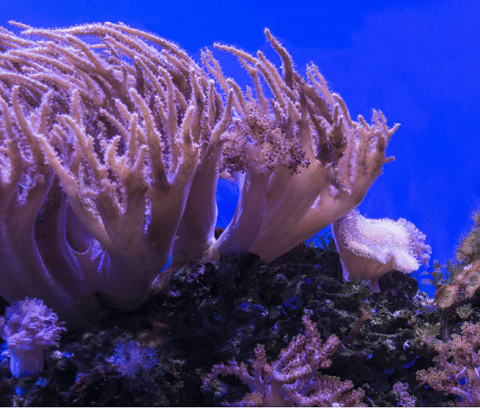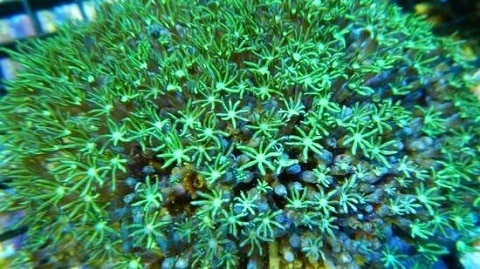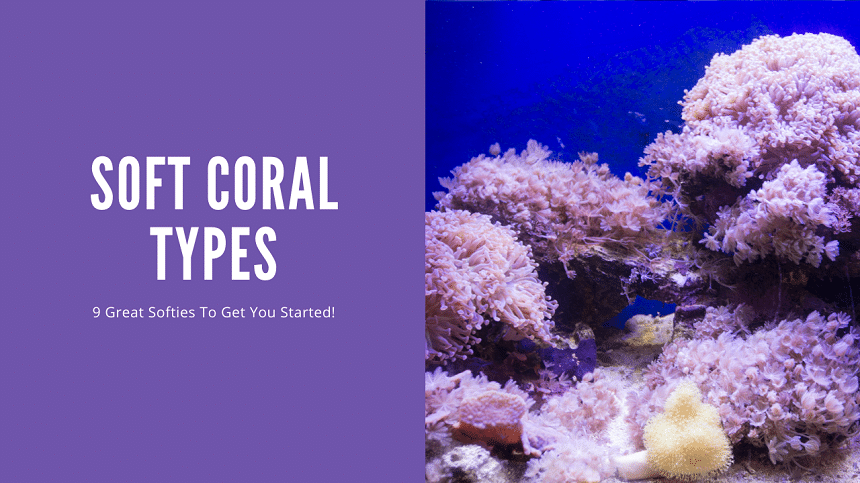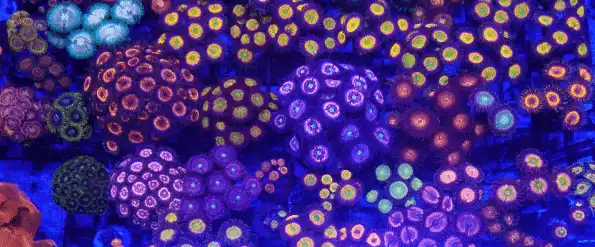Thank you for visiting! By the way… any links on this page that lead to products on Amazon and other stores/partners are affiliate links Aquarium Store Depot earns a commission if you make a purchase.
Coral reef tanks are a great way to add some life and color to your home. They can bring out the natural beauty of your fish and other marine inhabitants while also adding intrigue in your reef aquarium. Soft corals are an excellent addition to any tank because they offer superb coloration as well as providing nutrients for other organisms that live in your tank. These 9 soft coral types I recommend will look absolutely amazing in tanks!
Introduction
Soft corals are largely considered to be some of the easiest corals in the hobby. These corals usually lack a calcium carbonate skeleton and have very fleshy polyps. Some of the most popular soft corals to come across are zoanthids and mushroom corals, but there are many species and variations available.
Though these corals might seem easy, they can bring unique challenges to the tank, whether it be a toadstool coral that hasn’t opened in weeks or pulsing xenia that are taking over the rest of the display. When done correctly, they can bring as much color and excitement to the tank as any other species of more advanced coral.
How Many Species Are There?
In order to know how many soft coral species there are, we first need to understand the taxonomy of corals.
At the highest rank, corals belong to the Cnidaria phylum1, which also contains jellyfish. After that, they may be part of the Octocoralia subclass or Hexacorallia subclass in the Anthozoa class. Subclasses are dependent on the symmetry of the polyps; soft corals belong to Octocoralia while stony corals belong to Hexacorallia.
From these subclasses, corals then get broken up into four main orders that are commonly kept by reef tank hobbyists:
- Corallimorpharia (approx. 50 species). These are considered soft corals as they lack a skeleton entirely, like mushroom corals.
- Alcyonacea (approx. 1500 species). These corals are known as the true soft corals even though they contain sclerites, which are small pieces of calcium carbonate skeleton present in the flesh of the coral. Examples of Alcyonaceae are leather corals as well as gorgonians.
- Zoantharia (approx. 100 species). Zoanthids are also considered soft corals, though they commonly incorporate sand and other hard materials into their flesh for structure.
- Scleractinia (approx. 1600 species). These corals are considered true reef-building corals as they create their own calcium carbonate skeleton; this order contains large polyp stony (LPS) corals and small polyp stony (SPS) corals. Some of the most common species of Scleractinia are Acropora spp. and Euphyllia spp..
These approximations are always changing so there can never be a sure number. However, it can be assumed that there are about 1500 species of true soft coral. Consider that not even a fraction of these are available in the home aquarium hobby, though there is still an overwhelming selection to choose from.
It should also be noted that even though SPS and LPS are categorized together in the Scleractinia order, they are considered to be very different in the reef tank hobby.
The 9 Best Soft Coral Types (Species of Soft Corals)
Here are the most common species of soft coral you’re likely to come across at your local aquarium store and their care requirements.
We got a video above from our YouTube Channel that you can follow along. If you like our content, be sure to subscribe as we post new videos every week! We go into more details below in our blog (and have links where you can purchase them).
1. Zoanthids
Editor's Choice!
Zoas come in multiple colors and easy to care for. The perfect choice for nano tanks!
| Scientific Name | Zoanthus spp. |
| Difficulty Level | Easy-Moderate |
| Temperament | Not aggressive |
| PAR Requirements | Moderate (50-150 PAR) |
| Flow Requirements | Moderate |
| Placement | Middle, High |
| Origin | Worldwide in warm, shallow waters |
Zoanthids are loved by beginner and expert hobbyists alike. There are many varieties of zoanthid available, coming in all colors and patterns. This diversity can make some zoanthids go for thousands of dollars.
Zoanthids are very easy to care for if they like your tank; these corals are notorious for closing up for weeks at a time for apparently no reason at all. They can quickly overgrow other corals and their potential palytoxin can deter some hobbyists.
Otherwise, multiple types of zoanthid can make a beautiful zoa garden at low, medium, and high placements of the tank with moderate flow and lighting.
2. Mushroom Corals
Mushroom corals have exploded in variety over the last few years. Multiple colors available and lots of exotic varieties. Affordable and easy to care for!
| Scientific Name | Corallimorpharia Order (Actinodiscus/Discosoma spp., Rhodactis spp., and Ricordea spp.) |
| Difficulty Level | Easy |
| Temperament | Semi-Aggressive |
| PAR Requirements | Low-Moderate (<50-150 PAR) |
| Flow Requirements | Low |
| Placement | Bottom, Middle |
| Origin | Widespread, mainly Australia, Tonga, the Caribbean, and Indonesia |
The Mushrooms coral at first glance may not be the most exciting coral to have, though hobbyists especially favor the Ricordea species, R. florida and R. yuma. Mushroom corals can be hairy, bumpy, or smooth and can come in purples, blues, greens, oranges, yellows, and reds.
Mushroom corals are some of the easiest to frag, which can be good practice for beginner reefers. These corals also have a unique walking-propagation ability where they leave pieces of themselves behind to create new mushrooms. This can quickly lead to overgrowth, which can sometimes be difficult to control.
3. Toadstool Leather
This leather coral offers a showpiece sized coral that is easy to care for. Requires no dosing and thrives in a variety of conditions
| Scientific Name | Sarcophyton spp. |
| Difficulty Level | Easy |
| Temperament | Peaceful |
| PAR Requirements | Low-Moderate (<50-150 PAR) |
| Flow Requirements | Moderate-High |
| Placement | Bottom, Middle, Top |
| Origin | Throughout the Indo-Pacific (Fiji, Australia, Tonga, Solomon Islands) |
Toadstool corals are some of the largest corals available, with some species growing 2 feet across. Luckily, these corals are also very easy to frag in order to help control rapid growth. They are limited in colors, coming only in greens, browns, tans, and yellows, but can have varying tentacle lengths.
These corals regularly shed a thin layer of their flesh about once every month. This may be due to stress, but it is usually to help keep algae and other debris off the coral. Because of this regular shedding, they do best in moderate to high water flow.
4. Green Star Polyps

| Scientific Name | Pachyclavularia spp. |
| Difficulty Level | Easy |
| Temperament | Peaceful |
| PAR Requirements | Low-High (<50-200+ PAR) |
| Flow Requirements | Moderate-High |
| Placement | Bottom, Middle, Top |
| Origin | Throughout the Indo-Pacific (Fiji, Australia, Tonga, Solomon Islands) |
Green star polyps (GSP) are some of the fastest-growing soft corals, which is why some hobbyists avoid them entirely. It’s strongly recommended to keep them on a rock island on their own in order to prevent them from spreading everywhere; it is also very common to see them on the back of the reef tank to create a wall of shimmering green or on a glass-bottom to make a waving lawn.
While green star polyps are one of the best choices for beginner hobbyists, many reefers regret introducing them into their tanks. Luckily, they are easy to frag as well.
5. Pulsing Xenia

| Scientific Name | Xenia spp. |
| Difficulty Level | Easy |
| Temperament | Peaceful |
| PAR Requirements | Low-Moderate (<50-150 PAR) |
| Flow Requirements | Low-Moderate |
| Placement | Bottom, Middle, Top |
| Origin | Throughout the Indo-Pacific (Fiji, Australia, Tonga, Solomon Islands) |
Xenias are one of the most popular soft corals next to green star polyps. These pale pink and purple corals bring immense movement to the tank as they pulsate their polyps without the need for additional water flow.
Unfortunately, some xenia don’t pulse or stop after some time for unknown reasons even though they might be completely healthy otherwise. As long as they are kept in low to moderate flow and low to moderate lighting, they will continue growing regardless of if they stop pulsing.
6. Kenya Tree

| Scientific Name | Capnella spp. |
| Difficulty Level | Easy |
| Temperament | Peaceful |
| PAR Requirements | Low-Moderate (<50-150 PAR) |
| Flow Requirements | Low-Moderate |
| Placement | Bottom, Middle, Top |
| Origin | Throughout the Indo-Pacific (Fiji, Australia, Tonga, Solomon Islands) |
Kenya tree corals can fill up large spaces in the reef aquarium with their fluffy branches. Though they might be considered plain in their dull pink and brown colorations, these corals have a softness that not many other species offer.
The problem with Kenya tree corals is that they spread rapidly. These corals are able to propagate by sending off their branches to other parts of the tank where they quickly establish themselves; these new frags are also hard to completely remove from the rockwork, which makes them very difficult to control.
7. Colt

| Scientific Name | Klyxum sp. |
| Difficulty Level | Easy |
| Temperament | Peaceful |
| PAR Requirements | Low-Moderate (<50-150 PAR) |
| Flow Requirements | Low-Moderate |
| Placement | Bottom, Middle, Top |
| Origin | Throughout the Indo-Pacific (Fiji, Australia, Tonga, Solomon Islands) |
Colt corals (picture source) are very similar to Kenya tree corals and difficult to tell apart even though they’re in two totally different genera. There are a few ways to tell these two species apart.
First, colt corals have fuller and more transparent branches compared to the thick, opaque branches of Kenya trees. Second, colt corals can be described as more slimy than Kenya trees when handling, which resemble the feeling of a sturdier leather coral; remember, try avoiding touching your corals as much as possible to not stress them out.
8. Devil’s Hand

| Scientific Name | Lobophytum spp. |
| Difficulty Level | Easy |
| Temperament | Peaceful |
| PAR Requirements | Low-Moderate (<50-150 PAR) |
| Flow Requirements | Moderate-High |
| Placement | Bottom, Middle, Top |
| Origin | Throughout the Indo-Pacific (Fiji, Australia, Tonga, Solomon Islands) |
Devil’s hand corals are named after their unique fingerlike appearance. These corals are a type of leather coral, like toadstools, which means that they also shed due to stress or for cleaning; because of this, they need higher water flow to help remove the flaking flesh in the process.
Unlike other leather corals, devil’s hand corals have very short tentacles which can make them look like they’re not fully expanded.
9. Pipe Organ

| Scientific Name | Tubipora musica |
| Difficulty Level | Intermediate |
| Temperament | Peaceful |
| PAR Requirements | Low-Moderate (<50-150 PAR) |
| Flow Requirements | Moderate-High |
| Placement | Bottom, Middle, Top |
| Origin | Throughout the Indo-Pacific (Fiji, Australia, Tonga, Solomon Islands) and the Western Pacific Ocean |
Pipe organs aren’t very common to come across in the home aquarium even though they come in beautiful floral patterns. These corals are not your typical soft coral. In fact, these soft corals have an intricate red calcium carbonate skeleton, which earns them their musical name!
This slow-growing skeleton needs to be kept clean from algae and detritus with proper water flow. They also need available calcium and stable alkalinity to build their skeleton, which can make them more challenging than the other species on this list.
What Is The Difference Between These and Hard Corals?
When talking about aquarium corals, you may come across words like LPS, SPS, hard/stony, or soft corals. In general, soft corals are considered the easiest with LPS best for intermediate hobbyists and SPS being saved for only the most dedicated reefers. But anatomically, these corals are very different.
Hard Corals
Hard corals, also known as SPS, belong to the Scleractinia order and are responsible for reef-building. They form large calcium carbonate skeletons that house symbiotic zooxanthellae in fleshy polyps. As members of the Hexocorallia subclass, their polyp symmetry is divisible by six.
These skeletons are usually branched and form the picturesque reefs we are used to seeing. They house a plethora of life, including fish, invertebrates, bacteria, and other microorganisms.
Softer Corals
Soft corals–according to the aquarium hobby–belong to the Corallimorpharia, Alcyonacea, and Zoantharia orders. These corals do not form full calcium carbonate skeletons and create very fleshy polyps. Some species, like those from Alcyonacea, form smaller skeletal structures called sclerites. As members of the Octocoralia subclass, their polyp symmetry is divisible by eight.
Interestingly, most soft coral species do not have fossil records as the animal has no concrete structure that can be preserved.
Keeping Them In The Aquarium
Soft corals are considered to be some of the easiest corals to keep in the aquarium and are often recommended as corals for beginners. Many species do not require intense reef lighting or flow and they can grow very quickly in less-than-ideal conditions.
On the other hand, some hobbyists greatly struggle with keeping some of these ‘easy’ corals. In some cases, the tank might be considered too perfect for these undemanding species and the coral fails to thrive as a result.
For example, it is strongly believed that zoanthids favor dirtier water with plenty of available nutrients. More advanced hobbyists keeping delicate SPS might have water that is too clean and void of nutrients to sustain a healthy zoanthid colony.
So even though soft corals do not require much special attention, there is no guarantee that they will be easy in your aquarium setup.
What Is The Easiest Type To Keep?
With that being said, which soft corals are the easiest to keep? For the most part, all of them.
There are many options for beginners and advanced reefers alike to choose from. Here are the most common recommendations:
- Green star polyps
- Mushroom corals
- Leather corals
- Pulsing Xenia
- Zoanthids
As mentioned before, though these corals are generally considered easy, they can be some of the most challenging corals you have in your aquarium depending on your setup.
When Can You Add Them To The Aquarium?
If you’re a beginner just starting to explore the saltwater world of the aquarium-keeping hobby, you’ll be eager to add your first coral to the tank. In order to succeed in this hobby though, you will need lots of patience.
Though soft corals are very forgiving of poor water parameters, they are still much more difficult to keep than marine fish or freshwater plants. They need stability, available nutrients, good lighting, and good water flow. New setups rarely have any of these.
In short, it is not recommended to add soft corals to a newly established tank during the first 3 months. These 3 months test many new hobbyists with algae outbreaks, diatoms, Aiptasia, and livestock compatibility. Corals are expensive and it isn’t fair to them or worth the risk of introducing them into unfavorable conditions.
Instead, allow the tank to establish a good beneficial bacteria population. Control algae and find the perfect photoperiod for your setup. Figure out if your tank runs best with weekly or biweekly water changes (or none at all if you are brave enough😅) . Trace how your nutrient import and export changes daily. Then, you may add corals.
Soft corals are good starter corals for many as they don’t require nutrients to be dosed. As long as a reliable marine salt mix is being used and nutrients are being added into the tank via fish food, waste, and other detritus, your soft corals should be able to sustain themselves.
For mature tanks, soft corals can be added at any time. More importantly, it is necessary to find the right placement for them in order to keep them away from other corals. Though most soft corals are not capable of stinging, they can easily overgrow and shade out other species.
Closing Thoughts
Soft corals are some of the easiest species to keep and come in all colors, shapes, and sizes. There are some differences between the scientific classification for soft corals, LPS, and SPS that differ from aquarium standards, but all soft coral species generally require the same care.
With so many options to choose from, a soft coral and macroalgae setup might just be the next setup you have in mind for your own saltwater aquarium. Have any questions for me? Leave them in the comment section and let’s start a discussion. Happy Reefing!
- About the Author
- Latest Posts
I’m thrilled that you found Aquarium Store Depot! Here you’ll find information on fish, aquariums, and all things aquatics related. I’m a hobbyist (being doing this since I was 11) and here to help other hobbyists thrive with their aquariums! I adhere to a high quality Editorial Process and Review products with real life field usage and practical analysis.








